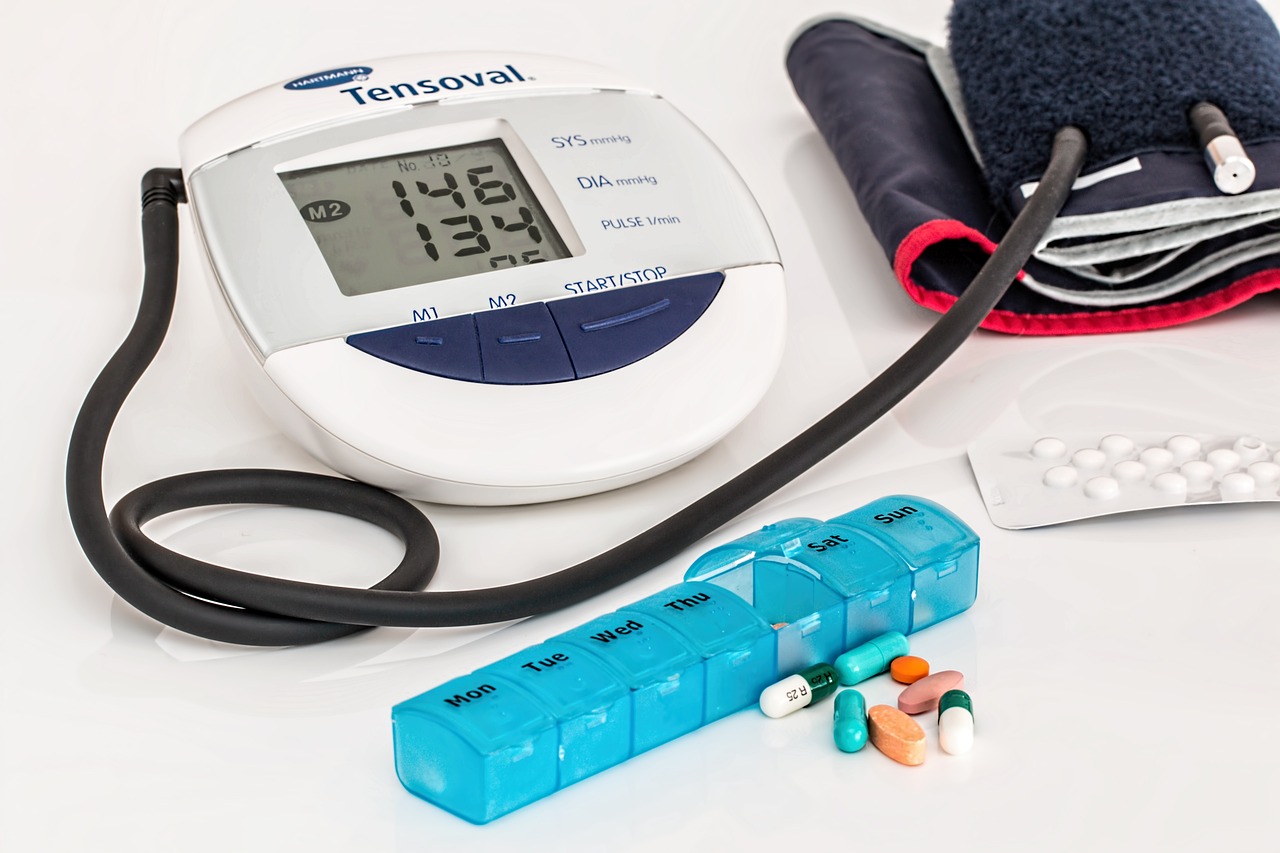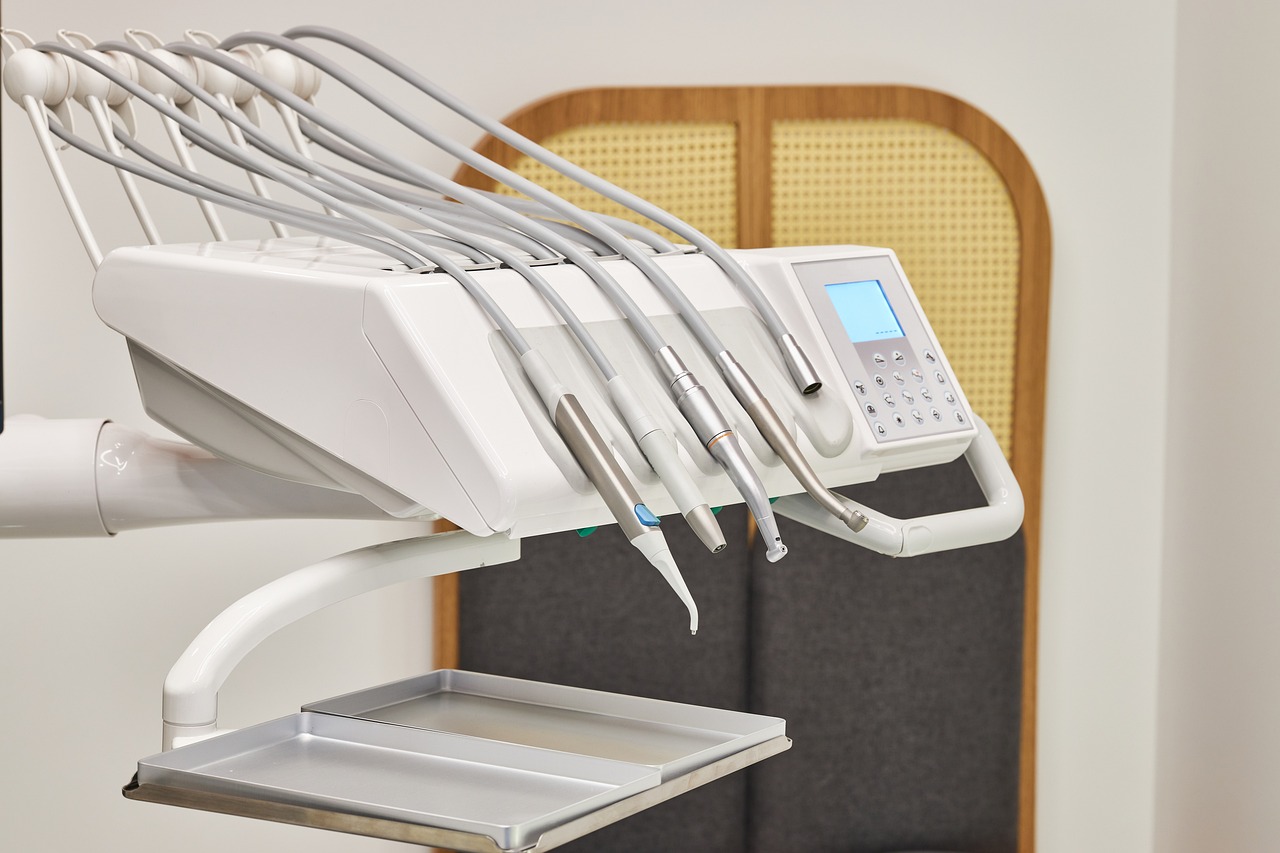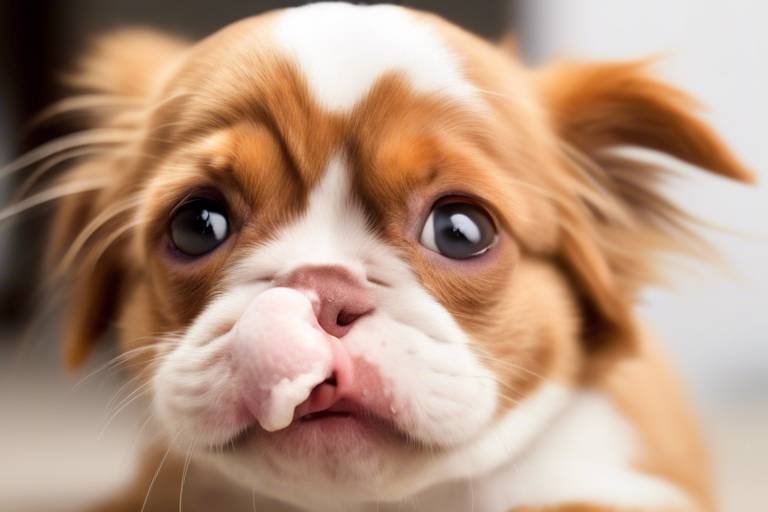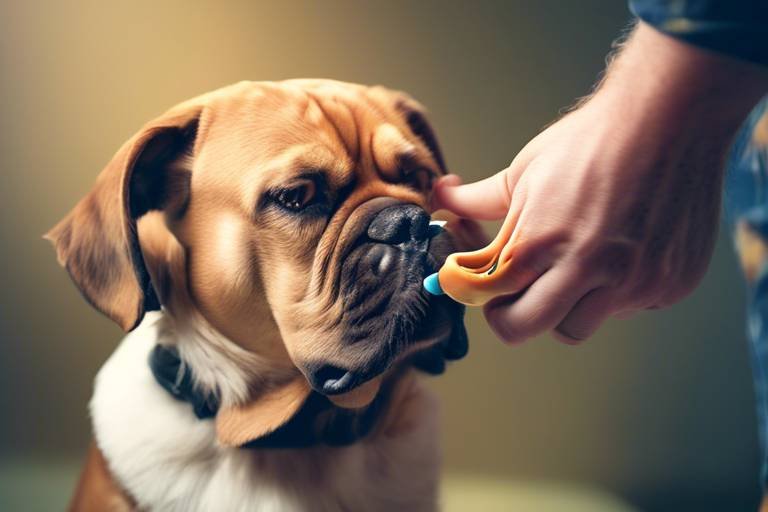How to Perform a Basic Assessment of Your Pet’s Health
As a loving pet owner, it’s essential to keep a close eye on your furry friend’s health. Just like us, pets can experience a range of health issues that may not always be obvious at first glance. Performing a basic health assessment can be a game-changer in ensuring your pet lives a long, happy, and healthy life. So, how do you go about it? In this article, we’ll walk you through some key indicators to look for, techniques to assess your pet’s health, and when it’s time to call in the professionals. Let’s dive in!
Evaluating your pet's body condition is crucial for maintaining their health. Just like humans, pets come in all shapes and sizes, but there are certain standards for what constitutes a healthy weight. To assess your pet's body condition, start by feeling their ribs. You should be able to feel them without too much pressure, but they shouldn’t be protruding. If you can easily see your pet's ribs, they might be underweight; conversely, if you can’t feel them at all, it could indicate obesity.
Additionally, look at your pet from above. You should notice a slight waist between their ribs and hips. If this is absent, it may be time to reevaluate their diet and exercise routine. Regular check-ups with your vet can also help you keep track of your pet's weight and overall body composition.
Behavioral changes can be one of the first signs that something is off with your pet. Pay attention to their eating habits, activity levels, and social interactions. For instance, if your usually playful pup suddenly becomes lethargic and uninterested in playtime, it could be a signal that something is wrong. Similarly, if your cat, who typically loves to cuddle, starts hiding away, it might be time to investigate further.
Monitoring these changes is crucial because pets can’t tell us when they’re feeling unwell. By keeping a close watch, you can catch potential health issues early. Remember, a change in behavior is often the first indicator of an underlying health problem.
Recognizing pain in pets can be challenging, as they often hide their discomfort well. However, there are common signs of pain you can look out for. Changes in posture, such as a hunched back or reluctance to move, can indicate that your pet is in pain. You might also notice them vocalizing more than usual or being unusually quiet. If your pet is limping or favoring a particular leg, that’s a clear sign they might be experiencing discomfort.
Understanding specific behaviors that may indicate pain in pets can lead to timely veterinary intervention. Here are some common indicators:
- Excessive grooming or licking of a specific area
- Hiding or seeking solitude
- Changes in appetite or eating habits
If you notice any of these signs, it’s essential to consult with your veterinarian to determine the cause and appropriate treatment.
Knowing when to consult a veterinarian is crucial for your pet’s well-being. If your pet shows persistent signs of pain or discomfort, or if you notice any sudden changes in behavior, it’s best to err on the side of caution. Some scenarios that warrant immediate professional evaluation include:
- Severe lethargy or unresponsiveness
- Difficulty breathing or persistent coughing
- Vomiting or diarrhea lasting more than 24 hours
Don’t wait too long to seek help; your pet’s health could depend on it!
Monitoring your pet's vital signs is an essential part of health assessment. Just like humans, pets have normal ranges for heart rate, respiratory rate, and temperature. To check your pet's heart rate, place your hand on their chest or feel their pulse on their inner thigh. A typical heart rate for dogs is between 60-100 beats per minute, while cats usually range from 140-220 beats per minute. For respiratory rate, simply count the number of breaths your pet takes in a minute while they are at rest. A normal rate is typically 10-30 breaths per minute for dogs and 20-30 for cats. Lastly, to check their temperature, you can use a digital thermometer. A normal temperature for pets is between 100.5°F and 102.5°F.
A pet's skin and coat condition can reveal a lot about their overall health. Dull fur, excessive shedding, or skin irritations can indicate allergies, parasites, or infections. When assessing your pet’s coat, run your fingers through their fur and check for any lumps, bumps, or unusual odors. If you notice any changes, it’s best to consult a vet for further evaluation.
Common skin problems in pets include rashes, lumps, and excessive shedding. Early recognition of these issues can lead to timely treatment and prevention of further complications. If your pet is scratching excessively or biting at their skin, it might be time to investigate potential allergies or skin infections.
Regular grooming is vital for maintaining your pet's skin and coat health. Not only does it keep their fur looking fabulous, but it also allows you to check for any irregularities. Establish a grooming routine that includes brushing, bathing, and regular check-ups with your vet. This way, you can identify potential health problems early on, keeping your pet happy and healthy.
Dental health is often overlooked in pets, yet it is critical for their overall well-being. Bad breath, swollen gums, and difficulty eating can all indicate dental issues. Regularly checking your pet’s mouth can help you catch problems before they escalate.
Identifying dental problems early can prevent serious health issues. Look out for:
- Bad breath
- Difficulty eating or chewing
- Swollen or bleeding gums
If you notice any of these signs, consult your veterinarian for an evaluation.
Creating a dental care routine for your pet is essential. Regular brushing, dental treats, and routine veterinary check-ups can help maintain your pet's oral health effectively. Make dental care a fun activity by using flavored toothpaste designed for pets, and reward them afterwards to create a positive association.
Q: How often should I perform a health assessment on my pet?
A: It's a good idea to perform a basic health assessment at least once a month, but more frequent checks are recommended for older pets or those with known health issues.
Q: What should I do if I notice a change in my pet's behavior?
A: If you notice any significant changes in your pet's behavior, it’s best to consult your veterinarian to rule out any underlying health issues.
Q: How can I keep my pet's teeth healthy?
A: Regular brushing, dental treats, and routine vet check-ups are key to maintaining your pet's dental health.

Understanding Your Pet's Body Condition
Evaluating your pet's body condition is crucial for maintaining their health. Just like us, pets can struggle with weight issues that can lead to serious health problems. So, how do you determine if your furry friend is at a healthy weight? It all starts with understanding their body composition, which includes weight, muscle tone, and fat distribution.
To begin your assessment, you can use a simple method known as the Body Condition Score (BCS). This scoring system typically ranges from 1 to 9, where 1 indicates an underweight pet and 9 signifies an obese one. A score of 5 is considered ideal. You can assess your pet's BCS by feeling their ribs and checking their waistline. If you can feel their ribs easily without excess fat covering, and they have a noticeable waist when viewed from above, your pet is likely at a healthy weight.
Here’s a quick reference table to help you understand the Body Condition Score:
| Score | Condition |
|---|---|
| 1 | Severely Underweight |
| 3 | Underweight |
| 5 | Ideal Weight |
| 7 | Overweight |
| 9 | Obese |
In addition to weight, muscle tone is another important factor. A healthy pet should have well-defined muscles, especially in their limbs and neck. If your pet feels like a sack of potatoes, it might be time for a little more playtime and a little less couch surfing! Regular exercise not only helps maintain a healthy weight but also supports muscle development.
Finally, keep an eye on your pet's overall body composition. Look for any noticeable changes in their shape or size. Sudden weight gain or loss can be a red flag, indicating potential health issues. If your pet is gaining weight, consider adjusting their diet and increasing their physical activity. On the other hand, if they are losing weight without a change in diet or activity level, it could be a sign of an underlying health problem that requires veterinary attention.
In summary, understanding your pet's body condition is about more than just looking at the scale. It involves a comprehensive assessment of their weight, muscle tone, and overall body composition. By keeping a close eye on these factors, you can ensure that your furry companion stays healthy, happy, and full of life!
- How often should I assess my pet's body condition? It's a good idea to check their body condition at least once a month, especially if they are on a weight management program.
- What should I do if my pet is overweight? Consult your veterinarian for a tailored weight loss plan that includes a balanced diet and exercise regimen.
- Can I use human weight scales for my pet? While it’s possible, it’s more effective to use a pet scale to get an accurate reading.

Observing Behavioral Changes
As a loving pet owner, your furry friend’s health and happiness are likely at the forefront of your mind. One of the most effective ways to assess your pet's well-being is by . Just like humans, pets can exhibit signs of distress or discomfort through their behavior. So, what should you be looking for? It's essential to pay attention to their eating habits, activity levels, and social interactions. These indicators can provide crucial insights into your pet's health status.
For instance, has your pet suddenly lost interest in their favorite food? A change in appetite can be a red flag, signaling potential health issues. Similarly, if your usually playful pup is now lounging around all day, it might be time to investigate further. Pets are creatures of habit, and any significant deviation from their norm can indicate that something is amiss. Remember, monitoring your pet's behavior is not just about spotting the obvious; it’s also about understanding the subtle nuances that can lead to early detection of health problems.
Moreover, social interactions are another critical aspect to observe. If your pet is usually the life of the party but suddenly starts to isolate themselves, this could be a sign of emotional distress or physical discomfort. Animals can’t communicate with words, but they often express their feelings through body language and behavior. For example, a dog that typically greets you at the door might start to hide when you arrive home. This change can indicate anxiety or pain, which shouldn't be ignored.
In addition to these observations, here are a few common behavioral changes to keep an eye on:
- Excessive vocalization: If your pet starts barking, meowing, or whining more than usual, they might be trying to tell you something.
- Changes in grooming habits: Over-grooming or neglecting grooming can indicate stress or health issues.
- Increased aggression: A normally docile pet that becomes aggressive might be in pain or feeling threatened.
Recognizing these signs early on can lead to timely veterinary intervention, which is crucial for your pet's health. Don’t hesitate to jot down any changes you notice; keeping a log can help you articulate your concerns during vet visits. The more information you provide, the better equipped your veterinarian will be to diagnose any potential issues.
In conclusion, being observant and proactive about your pet's behavior can make a world of difference. By staying in tune with their habits, you can catch potential health problems before they escalate. After all, your pet relies on you to keep them happy and healthy!
Q: What are some signs that my pet might be in pain?
A: Common signs include changes in posture, vocalizations, reluctance to move, excessive grooming, hiding, and changes in appetite. If you notice any of these, it’s time to consult your veterinarian.
Q: How can I monitor my pet's behavior effectively?
A: Keep a daily log of your pet's eating habits, activity levels, and social interactions. Note any changes, as these can be valuable information to share with your vet.
Q: When should I seek veterinary help for behavioral changes?
A: If you notice significant or sudden changes in your pet's behavior that last more than a day or two, it’s best to consult your veterinarian for a professional evaluation.
Identifying Signs of Pain
Recognizing pain in pets can feel like trying to solve a mystery without all the clues. Our furry friends can’t tell us when they’re hurting, making it essential for us as pet owners to be vigilant and observant. Pain can manifest in various ways, and being aware of these signs can lead to timely interventions that could save your pet from unnecessary suffering.
Firstly, changes in posture can be a significant indicator of discomfort. If your pet suddenly adopts a hunched position or seems to avoid putting weight on a particular leg, it could be a sign that something isn’t right. Similarly, if you notice your pet is more withdrawn or seems to be favoring one side of their body, it’s worth investigating further. Additionally, vocalizations can be telling; a sudden increase in whining, growling, or yelping when they’re usually quiet may indicate pain.
Another crucial aspect to monitor is your pet's activity level. If your dog, who usually loves to chase after balls, suddenly becomes lethargic or disinterested in their favorite activities, this behavioral change could signal discomfort. Cats can be just as subtle; if your feline friend is hiding more than usual or avoiding interaction, it could be a sign that they’re not feeling well.
To help you identify signs of pain more effectively, here are some common indicators to watch out for:
- Excessive grooming or licking of a specific area
- Changes in appetite, such as eating less or refusing food altogether
- Restlessness or difficulty finding a comfortable position
- Unexplained aggression or irritability
- Changes in sleeping patterns, such as increased sleeping or restlessness during sleep
Understanding these signs can be crucial for early detection of health issues. For example, if you notice your pet excessively licking a certain spot, it could indicate pain or irritation in that area, perhaps due to an injury or skin condition. Moreover, behavioral changes can often be the first clue that something is amiss, so keeping a close eye on your pet’s usual habits is vital.
In conclusion, being proactive about observing your pet's behavior and physical condition can make a significant difference in their quality of life. If you suspect your pet is in pain, don’t hesitate to reach out to a veterinarian. After all, just like us, our pets deserve to live a happy and pain-free life!
Q: How can I tell if my pet is in pain?
A: Look for signs such as changes in posture, vocalizations, activity levels, and grooming behavior. If your pet seems unusually withdrawn or aggressive, it may indicate discomfort.
Q: Is it normal for pets to hide when they are in pain?
A: Yes, many pets instinctively hide when they are in pain as a survival mechanism. This behavior can make it challenging to detect pain, so it’s essential to be observant of any changes in their usual habits.
Q: When should I take my pet to the vet for pain?
A: If you notice any persistent signs of pain or discomfort, it’s best to consult your veterinarian. Early intervention can prevent further complications and improve your pet’s quality of life.
Common Pain Indicators
Understanding your pet's pain can sometimes feel like deciphering a secret code. Pets are masters at hiding discomfort, making it essential for owners to be observant. One of the most common indicators of pain in pets is a change in their grooming habits. For instance, if your cat suddenly starts over-grooming a specific area or your dog begins to avoid grooming altogether, it could signal that something is amiss. Additionally, pets may exhibit behavioral changes such as increased irritability or withdrawal from social interactions. Just like us, they might become less playful or even aggressive if they're in pain.
Another telltale sign of discomfort is a change in posture or movement. If your dog hesitates to jump onto the couch or your cat struggles to climb stairs, they could be experiencing pain. Pay attention to their walking patterns; a limp or a change in gait can be significant indicators. Also, observe their vocalizations. Unusual whining, growling, or yowling can often point to underlying issues that require attention.
Here are some common indicators of pain in pets:
- Excessive Grooming: This can indicate skin irritation or pain in a specific area.
- Hiding: If your pet is retreating to their favorite hiding spot, they might be trying to cope with discomfort.
- Changes in Appetite: A sudden loss of interest in food can be a red flag.
- Altered Sleep Patterns: If your pet seems restless or sleeps more than usual, this could be a sign of pain.
Recognizing these signs early can lead to timely veterinary intervention, which is critical for your pet's health. Don't hesitate to consult your veterinarian if you notice any of these indicators. Remember, your pet relies on you to be their voice, especially when they can’t express their discomfort.
Q: How can I tell if my pet is in pain?
A: Look for changes in behavior such as excessive grooming, hiding, changes in appetite, or altered sleep patterns. Also, pay attention to their posture and vocalizations.
Q: Is it normal for pets to hide when they are in pain?
A: Yes, many pets instinctively hide when they are in pain as a survival mechanism. It's essential to monitor their behavior closely.
Q: When should I take my pet to the vet?
A: If you notice any signs of pain that persist for more than a day or two, or if your pet's behavior changes significantly, it's best to consult your veterinarian for a professional evaluation.
When to Seek Veterinary Help
Knowing when to consult a veterinarian is crucial for your pet's well-being. Just like we have our own warning signs when something isn't right, our furry friends do too. It's essential to stay alert and recognize these signals so that we can act quickly. If you notice any of the following symptoms, it’s time to pick up the phone and schedule a vet appointment:
- Persistent Vomiting or Diarrhea: If your pet has been vomiting or experiencing diarrhea for more than 24 hours, it could indicate a more serious issue. Dehydration can set in quickly, especially in small animals.
- Changes in Appetite: A sudden increase or decrease in your pet's food intake can be a red flag. If they refuse to eat for more than a day or seem excessively hungry, it’s worth investigating.
- Difficulty Breathing: Labored or rapid breathing can signal respiratory distress, which requires immediate attention. If your pet is wheezing or struggling to catch their breath, don’t hesitate.
- Unusual Behavior: If your pet is lethargic, hiding more than usual, or showing signs of aggression or anxiety, it might be a sign of pain or illness.
- Visible Injuries: Cuts, swelling, or any visible wounds should be examined by a vet, especially if they look infected or are not healing properly.
Additionally, keep an eye on any changes in your pet's weight, as sudden weight loss or gain can indicate underlying health problems. Regular check-ups are also a good way to catch issues before they escalate. Just like we go for annual physicals, our pets benefit from routine veterinary visits. These appointments can help with vaccinations, dental care, and overall health assessments.
Remember, when in doubt, it's always better to err on the side of caution. Your pet relies on you to advocate for their health. If something feels off, trust your instincts and seek professional help. A quick visit to the vet can lead to early intervention and a better outcome for your furry companion.
1. How often should I take my pet to the vet?
Generally, adult pets should see a veterinarian at least once a year for a routine check-up. However, puppies, kittens, and senior pets may require more frequent visits.
2. What are the signs that my pet is in pain?
Signs of pain can include whining, limping, changes in appetite, excessive grooming, or hiding. If you notice these behaviors, it’s essential to consult your vet.
3. Can I treat my pet's health issues at home?
While some minor issues can be managed at home, it’s always best to consult your veterinarian for advice. They can provide the most accurate diagnosis and treatment plan.
4. What should I do in case of an emergency?
If your pet is experiencing a medical emergency, such as difficulty breathing or severe bleeding, seek veterinary care immediately. Knowing the location of your nearest emergency vet clinic can save valuable time.
5. How can I prepare for a vet visit?
Bring any medical records, a list of symptoms, and any medications your pet is currently taking. This information can help the vet provide the best care possible.
Checking Vital Signs
Monitoring your pet's vital signs is an essential part of assessing their health. Just like how you might check your own heartbeat or temperature when feeling under the weather, your furry friend also has vital signs that can give you a glimpse into their overall well-being. Understanding these signs can help you catch potential issues before they escalate. So, what exactly should you be looking for?
First, let’s dive into the three main vital signs you should monitor: heart rate, respiratory rate, and temperature. Each of these indicators plays a crucial role in revealing your pet's health status. Here’s a quick breakdown:
| Vital Sign | Normal Range | What to Watch For |
|---|---|---|
| Heart Rate | 60-120 beats per minute (dogs), 140-220 beats per minute (cats) | Rapid heart rate, irregular beats |
| Respiratory Rate | 10-30 breaths per minute (dogs), 20-30 breaths per minute (cats) | Labored breathing, excessive panting |
| Temperature | 101-102.5°F (dogs and cats) | Fever or hypothermia (below 99°F or above 103°F) |
To check your pet's heart rate, you can place your hand on their chest or feel their pulse on the inside of their thigh. Count the beats for 15 seconds and multiply by four to get the beats per minute. For respiratory rate, simply observe your pet’s breathing for 15 seconds and multiply by four as well. As for their temperature, a digital rectal thermometer designed for pets is the most accurate method. Just remember to use a lubricant and be gentle!
It’s important to note that while these ranges are general guidelines, individual pets may vary. Factors like age, breed, and activity level can influence what’s normal for your furry friend. If you notice any significant deviations from these ranges, it’s time to consult your veterinarian. Keeping a record of these vital signs can also be incredibly useful for your vet during check-ups.
In conclusion, regularly checking your pet's vital signs is a proactive approach to their health. Think of it as a routine pit stop in a race; it’s essential for ensuring your pet runs smoothly and stays in peak condition. By being attentive to these vital indicators, you can help catch any potential health issues early, ensuring your beloved companion enjoys a long, happy life!
- How often should I check my pet's vital signs? It's a good practice to check them at least once a month, or more frequently if your pet has existing health issues.
- What should I do if I notice abnormal vital signs? If you observe any unusual readings, contact your veterinarian immediately for advice.
- Can stress affect my pet's vital signs? Yes, stress can lead to elevated heart rates and respiratory rates, so try to keep your pet calm during assessments.

Skin and Coat Health
Taking care of your pet's skin and coat is not just about aesthetics; it's a crucial part of their overall health. A shiny coat and healthy skin can be indicators of a happy, well-nourished pet. However, when you notice changes in your pet's skin or coat, it can signal underlying health issues that need attention. For instance, excessive itching, redness, or bald patches can indicate allergies or infections. It's essential to regularly check for these signs, as early detection can lead to more effective treatments.
One of the first steps in assessing your pet's skin and coat health is to look for common issues. These can include:
- Allergies: Pets can be allergic to various substances, including certain foods, pollen, or even flea bites.
- Parasites: Fleas, ticks, and mites can cause significant discomfort and lead to skin infections.
- Infections: Bacterial or fungal infections can manifest as rashes or unusual lumps.
To effectively monitor your pet's skin and coat, consider establishing a routine grooming schedule. Regular grooming not only helps in keeping your pet's coat clean and free of tangles but also allows you to examine their skin closely. During grooming sessions, check for any unusual lumps, bumps, or irritations. It's like a mini health check-up that can save you from potential vet visits down the line.
Additionally, maintaining a balanced diet rich in essential fatty acids can significantly improve your pet's skin and coat health. Foods that are high in omega-3 and omega-6 fatty acids help promote a shiny coat and reduce inflammation. If you're unsure about your pet's diet, consult your veterinarian for tailored advice.
In conclusion, keeping an eye on your pet's skin and coat is vital. Regular checks and grooming can help you catch any issues early, ensuring your furry friend remains healthy and comfortable. Remember, your pet relies on you to keep them safe and sound, so don't overlook the importance of their skin and coat health!
Q: How often should I groom my pet?
A: The frequency of grooming depends on your pet's breed and coat type. Long-haired breeds may require grooming several times a week, while short-haired pets may only need grooming once a month.
Q: What are the signs of skin allergies in pets?
A: Common signs include excessive scratching, biting at the skin, red or inflamed areas, and hair loss. If you notice these symptoms, consult your veterinarian.
Q: Can diet affect my pet's coat condition?
A: Absolutely! A diet rich in essential fatty acids can improve coat health. Consider foods that include fish oil or flaxseed oil.
Q: When should I take my pet to the vet for skin issues?
A: If you notice persistent itching, hair loss, or any unusual lumps or bumps, it's best to consult your veterinarian to rule out any serious conditions.
Identifying Skin Issues
When it comes to your pet's health, their skin can be a telling indicator of underlying problems. Just like a window into their overall well-being, the condition of your pet’s skin and coat can reveal a lot about what’s going on beneath the surface. Are you noticing any unusual changes? Perhaps your furry friend is scratching more than usual, or you’ve spotted some unusual bumps or rashes. These could be signs of skin issues that need your attention.
One of the most common skin problems in pets is allergies. Allergies can arise from various sources, including food, environmental factors, or even flea bites. If your pet is frequently itching or biting at their skin, it could be a response to allergens. Additionally, keep an eye out for redness, swelling, or flaky skin, which may indicate an allergic reaction. In some cases, you might notice a change in your pet’s behavior—like increased restlessness or irritability—due to the discomfort caused by these skin conditions.
Another issue to look out for is the presence of parasites. Fleas, ticks, and mites can wreak havoc on your pet’s skin, leading to irritation and infection. If you notice your pet excessively grooming themselves or developing hot spots—localized areas of inflamed skin—this could be a sign of a parasitic infestation. Regularly checking your pet for these unwanted guests is crucial, especially during warmer months when these pests are more prevalent.
In addition to allergies and parasites, skin infections can also pose a significant threat to your pet’s health. Bacterial or fungal infections may manifest as rashes, lumps, or even hair loss. If your pet's skin appears red, swollen, or has an unusual odor, it’s time to take action. Early detection is key; the sooner you address these issues, the better the outcome for your beloved companion.
Here are a few key signs to monitor for when assessing your pet's skin health:
- Excessive scratching or licking
- Redness or inflammation
- Unusual lumps or bumps
- Hair loss in patches
- Bad odor emanating from the skin
Remember, while you can perform a basic assessment at home, it’s essential to consult with a veterinarian if you notice any concerning changes. Your vet can provide a thorough examination and recommend appropriate treatments, ensuring your pet stays happy and healthy.
Q: How can I tell if my pet has skin allergies?
A: Look for signs such as excessive scratching, licking, or biting at the skin, along with redness or swelling. If you suspect allergies, consult your veterinarian for a proper diagnosis and treatment plan.
Q: What should I do if I find lumps on my pet’s skin?
A: While not all lumps are cause for concern, it’s best to have any new or unusual lumps checked by a veterinarian to rule out serious conditions.
Q: How often should I groom my pet to keep their skin healthy?
A: Regular grooming is essential. Depending on the breed, you may need to groom your pet weekly or even daily to remove dirt, debris, and loose hair, which can help prevent skin issues.
Q: Are there any home remedies for minor skin irritations?
A: Some mild skin irritations can be treated with soothing oatmeal baths or aloe vera. However, always consult with your vet before trying home remedies to ensure they are safe for your pet.
The Importance of Regular Grooming
Regular grooming is not just about keeping your pet looking fabulous; it's a crucial aspect of their overall health and well-being. Think of grooming as a health check-up that you can perform at home. Just like we feel refreshed after a good shower, our furry friends benefit immensely from regular grooming sessions. These moments allow you to bond with your pet while simultaneously keeping an eye on their physical condition.
When you groom your pet, you're not just brushing their coat; you're also checking for any unusual signs that could indicate health problems. For instance, while brushing, you might notice lumps, bumps, or skin irritations that could require veterinary attention. It's like being a detective, searching for clues to ensure your pet remains healthy and happy.
Moreover, regular grooming helps to prevent matting and tangles, especially in long-haired breeds. Imagine wearing a sweater that gets tighter and tighter; that's how your pet feels with matted fur. This can lead to discomfort and even skin infections if not addressed. Additionally, grooming helps to distribute natural oils throughout your pet's coat, promoting a shiny and healthy appearance.
Another significant benefit of grooming is the opportunity to check your pet's ears, eyes, and paws. These areas can often go unnoticed but can harbor issues such as infections or irritations. For example, if you see redness or discharge in the ears, it may indicate an ear infection that needs to be treated promptly. By incorporating these checks into your grooming routine, you're taking proactive steps to ensure your pet's health.
So, how often should you groom your pet? It really depends on the breed and coat type. Here’s a quick guide:
| Pet Type | Grooming Frequency |
|---|---|
| Short-Haired Dogs | Every 1-2 weeks |
| Long-Haired Dogs | Every week |
| Cats (Short-Haired) | Every 2-4 weeks |
| Cats (Long-Haired) | Every week |
Remember, grooming is not just a chore; it's an opportunity to connect with your pet, check their health, and keep them comfortable. So, grab that brush, put on some tunes, and make grooming a fun and enjoyable experience for both you and your furry companion!
- How often should I groom my pet? It varies by breed, but generally, short-haired pets need grooming every 1-2 weeks, while long-haired pets require weekly grooming.
- Can I groom my pet at home? Absolutely! Regular grooming can be done at home, but some pets may require professional grooming for specific styles or thorough care.
- What tools do I need for grooming? Basic grooming tools include a brush, comb, nail clippers, and possibly shampoo for baths. Choose tools that suit your pet's coat type.
- What if I find a lump while grooming? If you notice any unusual lumps or bumps, consult your veterinarian for a thorough examination.

Monitoring Dental Health
When it comes to our furry friends, dental health is often overshadowed by other aspects of their care. However, just like in humans, maintaining good oral hygiene is crucial for your pet's overall well-being. Did you know that poor dental health can lead to serious health issues, including heart disease and kidney problems? This is why it's essential to monitor your pet's dental health regularly. But how do you know if your pet's mouth is in good shape? Let’s dive into the signs of dental issues and how to establish an effective dental care routine.
First off, it's important to recognize the common signs that might indicate your pet is experiencing dental problems. If you notice your pet exhibiting any of the following symptoms, it may be time to take action:
- Bad breath: While pets naturally have a certain smell, an overwhelming odor can indicate dental disease.
- Difficulty eating: If your pet is hesitant to chew or seems to be favoring one side of their mouth, they may be in pain.
- Swollen gums: Healthy gums should be pink and firm; any redness or swelling can be a sign of infection.
- Excessive drooling: While some drooling is normal, an increase can signal dental discomfort.
These symptoms can be your pet's way of telling you that something isn't right. If you spot any of these signs, it's crucial to consult your veterinarian promptly. They can provide a thorough examination and recommend the best course of action.
But what can you do to prevent these issues from arising in the first place? Establishing a dental care routine for your pet is vital. Here are some tips to get you started:
- Brushing: Ideally, you should brush your pet's teeth daily. Use a toothbrush and toothpaste specifically designed for pets. Start slowly to get them used to the process.
- Dental treats: Incorporating dental chews into your pet's diet can help reduce plaque and tartar buildup.
- Regular vet check-ups: Schedule dental cleanings with your veterinarian at least once a year. They can perform professional cleanings and check for any underlying issues.
It's interesting to note that pets can develop dental issues as early as three years old. Therefore, starting a dental care routine early can save your pet from unnecessary pain and expensive treatments down the line. Just like you wouldn’t ignore your own dental health, don’t overlook your pet’s!
In conclusion, monitoring your pet's dental health is an essential aspect of their overall care. By being vigilant and proactive, you can help your furry friend maintain a healthy mouth, which in turn contributes to a longer, happier life. Remember, your pet relies on you to take care of them, so let’s make sure their smile stays bright!
Q: How often should I brush my pet's teeth?
A: Ideally, you should brush your pet's teeth daily, but even a few times a week can make a significant difference.
Q: Are there special toothpastes for pets?
A: Yes, always use toothpaste formulated for pets. Human toothpaste can be harmful to animals.
Q: What are the signs that my pet might need a dental cleaning?
A: Signs include bad breath, difficulty eating, swollen gums, and excessive drooling. If you notice any of these, consult your vet.
Q: Can dental treats replace brushing?
A: While dental treats can help reduce plaque, they should not replace regular brushing. They are best used in conjunction with a brushing routine.
Q: How much does a veterinary dental cleaning cost?
A: Costs can vary widely depending on your location and the specific needs of your pet. It's best to consult your vet for an estimate.
Signs of Dental Issues
When it comes to our beloved pets, their dental health is often an area that gets overlooked. Just like humans, pets can suffer from a range of dental issues that can lead to serious health problems if not addressed. So, how can you tell if your furry friend is experiencing dental issues? It’s essential to be vigilant and aware of the signs that may indicate something is amiss in your pet's mouth.
One of the most noticeable signs of dental problems is bad breath. While a little doggy breath can be normal, a foul odor can indicate the presence of plaque, tartar, or even gum disease. If your pet’s breath smells like something died, it’s time to take a closer look. Additionally, you might notice your pet struggling to eat or showing reluctance to chew their favorite treats. This could be a sign that they are experiencing pain or discomfort when biting down, which can stem from issues like tooth decay or gum infections.
Another indicator of dental problems is swollen or bleeding gums. If you notice your pet’s gums appear red or inflamed, or if there’s blood when they eat or after you brush their teeth, this is a clear signal that something is wrong. Furthermore, keep an eye out for excessive drooling. While some drooling is normal, an increase in saliva production can be a sign of oral discomfort or dental disease.
It’s also worth mentioning that pets with dental issues may exhibit behavioral changes. For instance, they might become more irritable or withdrawn, avoiding playtime or interaction. In some cases, pets may paw at their mouths or show signs of distress when you touch their face. These behaviors can indicate that they are in pain and need immediate attention.
To help you identify these signs clearly, here’s a quick summary of common indicators of dental issues in pets:
- Bad breath
- Difficulty eating or chewing
- Swollen, red, or bleeding gums
- Excessive drooling
- Pawing at the mouth or face
- Behavioral changes, such as irritability or withdrawal
Recognizing these signs early can be a game-changer for your pet’s health. If you suspect your furry friend is experiencing dental issues, don’t hesitate to reach out to your veterinarian. Regular dental check-ups and good oral hygiene can prevent many of these problems from developing in the first place, ensuring your pet stays happy and healthy.
Q: How often should I brush my pet's teeth?
A: Ideally, you should brush your pet's teeth at least two to three times a week. Daily brushing is even better to prevent plaque buildup.
Q: What are some dental treats I can give my pet?
A: Look for dental chews specifically designed to promote oral health. These treats can help reduce tartar and plaque while keeping your pet entertained.
Q: Can dental problems lead to other health issues?
A: Yes, dental problems can lead to serious health issues, including heart disease and infections. It's crucial to maintain your pet's dental hygiene to prevent these complications.
Q: How can I tell if my pet is in pain due to dental issues?
A: Signs of pain can include reluctance to eat, pawing at the mouth, changes in behavior, and excessive drooling. If you notice any of these signs, consult your veterinarian.
Establishing a Dental Care Routine
Creating a dental care routine for your pet is not just a good idea; it's essential for their overall health and happiness. Just like us, pets can suffer from dental issues that can lead to serious health problems if left unchecked. Imagine your furry friend trying to enjoy their favorite treat but wincing in pain because of a dental issue. That’s not a scenario any pet owner wants to face! So, let’s dive into how you can set up a routine that keeps those pearly whites in top shape.
First and foremost, brushing your pet's teeth should be a regular part of their grooming routine. Ideally, you should aim to brush your pet's teeth at least two to three times a week. Use a toothbrush and toothpaste specifically designed for pets, as human products can be harmful to them. Start slowly; allow your pet to get used to the toothbrush and the taste of the toothpaste. You might even want to make it a fun game to get them excited about dental care!
In addition to brushing, consider incorporating dental treats into your pet's diet. These treats are designed to help reduce plaque and tartar buildup while providing a tasty reward for your pet. However, be cautious about how many treats you give; you don’t want to overdo it and affect their overall diet. Look for products that have the Veterinary Oral Health Council (VOHC) seal of approval, as these are proven to be effective in promoting dental health.
Another important aspect of your pet’s dental care routine is scheduling regular veterinary check-ups. Your veterinarian can perform professional cleanings and check for any underlying dental issues that may not be visible to the naked eye. It’s recommended to have these check-ups at least once a year, but your vet may suggest more frequent visits depending on your pet's specific needs.
Lastly, don’t forget to monitor your pet’s oral health daily. Keep an eye out for signs of dental problems, such as bad breath, swollen gums, or difficulty eating. If you notice any of these symptoms, it’s crucial to consult your veterinarian immediately. Remember, the earlier you catch a problem, the easier it is to treat!
Establishing a dental care routine for your pet can seem daunting at first, but with a little patience and consistency, it can become a seamless part of your pet’s life. Not only will your pet thank you for it with wagging tails and happy purrs, but you’ll also enjoy the peace of mind that comes with knowing you’re doing everything you can to keep your furry friend healthy.
- How often should I brush my pet's teeth?
Ideally, you should brush your pet's teeth at least 2-3 times a week, but daily brushing is even better. - What type of toothpaste should I use?
Always use toothpaste that is specifically designed for pets, as human toothpaste can be toxic to them. - Are dental treats effective?
Yes, dental treats can help reduce plaque and tartar buildup, but they should be used in conjunction with regular brushing. - How can I tell if my pet has dental issues?
Look for signs like bad breath, swollen gums, difficulty eating, or excessive drooling. If you notice any of these, consult your veterinarian. - How often should my pet see the vet for dental check-ups?
It’s recommended to have a dental check-up at least once a year, but some pets may need more frequent visits based on their dental health.
Frequently Asked Questions
- How can I evaluate my pet's body condition?
To evaluate your pet's body condition, start by feeling their ribs. You should be able to feel them without excessive pressure. Look for a noticeable waist when viewed from above and a tucked abdomen when viewed from the side. Regular weigh-ins can also help you track their weight over time.
- What behavioral changes should I watch for in my pet?
Key behavioral changes to monitor include alterations in eating habits, such as sudden loss of appetite or excessive eating. Also, keep an eye on their activity levels; if your pet seems lethargic or less playful than usual, it could indicate a health issue. Changes in social interactions, like withdrawal or aggression, are also red flags.
- How can I tell if my pet is in pain?
Signs of pain in pets can be subtle. Look for changes in posture, such as hunching or limping. Listen for unusual vocalizations, like whining or growling, and notice if your pet is reluctant to move or engage in activities they usually enjoy. Excessive grooming or hiding can also be indicators of discomfort.
- When should I take my pet to the vet?
If you notice any persistent signs of pain, significant changes in behavior, or if your pet has trouble breathing, it's time to consult your veterinarian. Additionally, if you observe unusual symptoms like vomiting, diarrhea, or changes in appetite lasting more than a day, seek professional help to avoid complications.
- What vital signs should I monitor in my pet?
Monitoring your pet's vital signs is crucial. Check their heart rate by feeling their pulse, usually located on the inside of their thigh. You can also assess their respiratory rate by counting the number of breaths they take in a minute. Lastly, take their temperature using a digital thermometer designed for pets, aiming for a normal range of 100.5°F to 102.5°F.
- How can I assess my pet's skin and coat health?
Regularly inspect your pet's skin and coat for signs of allergies, parasites, or infections. Look for rashes, lumps, or excessive shedding, and feel for any unusual bumps. A shiny, clean coat often indicates good health, while a dull coat may signal underlying issues.
- What are the signs of dental issues in pets?
Watch for bad breath, difficulty eating, or swollen gums, as these may indicate dental disease. If you notice your pet pawing at their mouth or being reluctant to chew, it’s a good idea to schedule a dental check-up with your vet to prevent more serious health issues.
- How can I establish a dental care routine for my pet?
Creating a dental care routine involves regular brushing with pet-safe toothpaste and providing dental treats or chews that promote oral health. Schedule routine vet check-ups for professional cleanings and advice tailored to your pet's specific needs.



















